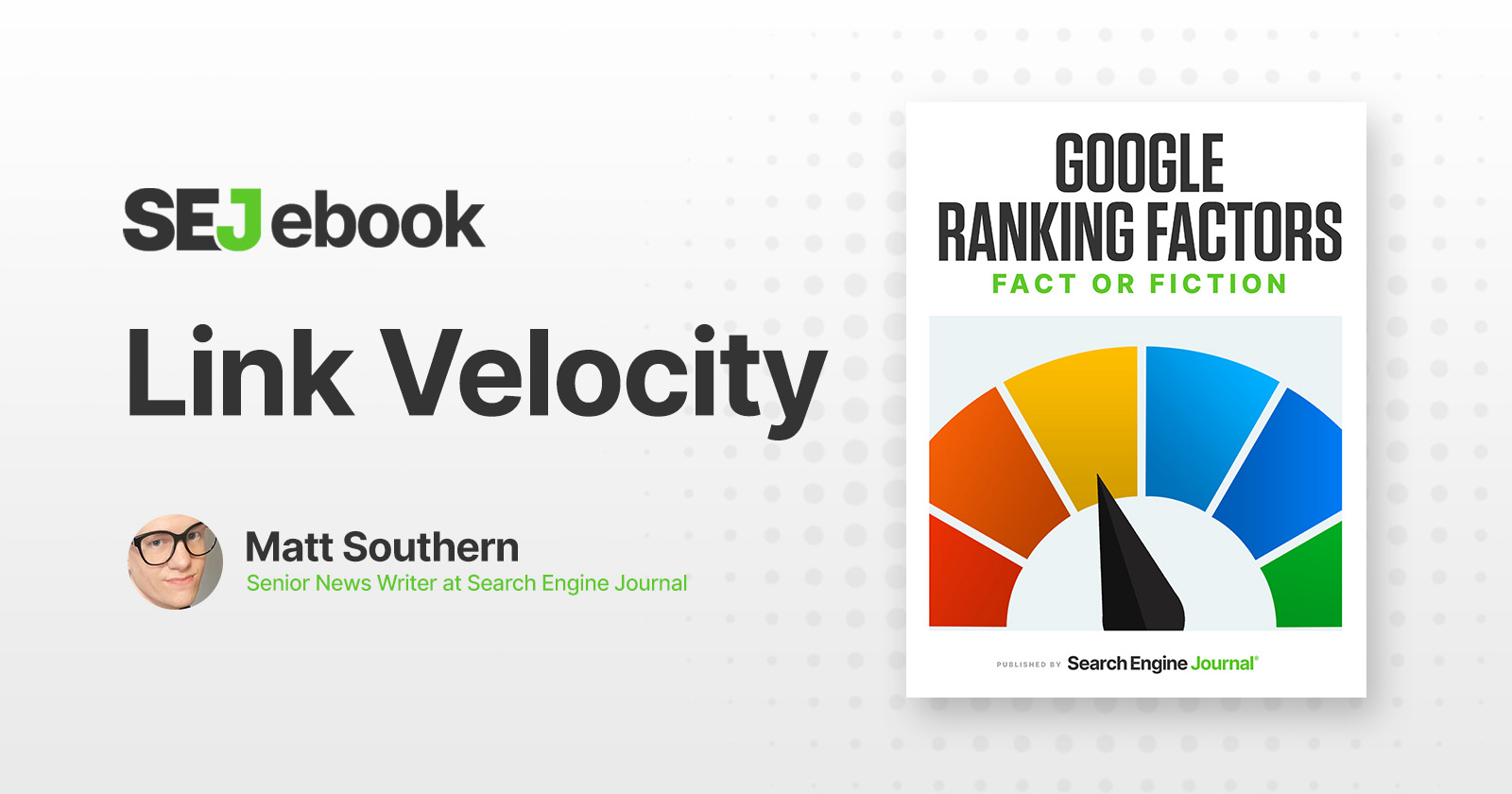SEO
Is It A Ranking Factor?

Quickly gaining a lot of links from other sites sounds like it should be a positive thing for any website.
But could it actually hurt, rather than help, your rankings?
Or does link velocity not matter at all to Google? Is it, in fact, just some made-up SEO term?
Read on as we investigate the origins of link velocity and whether it’s something you need to be genuinely concerned about in SEO.
The Claim: Link Velocity As A Ranking Factor
Link velocity refers to a theory that the speed at which a website gains links has the potential to impact rankings, either positively or negatively.
Link Velocity = Good
Years ago, having a high link velocity in a short period of time was viewed by some as a good thing in the SEO industry, one that could positively influence your Google rankings.
Link velocity was mentioned in articles and during conference sessions – because in those days link building was more about quantity than quality.
Want to get a webpage to rank quickly? Build a whole bunch of links to it fast.
But the idea of quantity over quality changed after Google launched the Penguin algorithm.
Link Velocity = Bad
The belief here is that gaining links too fast can cause a website to get penalized or demoted in search results.
It is based on the idea that Google will interpret a quick increase in inbound links as a sign that the website is trying to manipulate its search rankings.
Understandably, the idea of link velocity can be concerning for everyone who is averse to getting inadvertently penalized for acquiring links.
The growth of a website’s link profile is largely out of its control.
If a site publishes a great piece of content, for example, many other sites may reference it within a short time frame, resulting in a number of links gained all at once.
Were link velocity to work as SEO experts claim, the website in the above example could receive a penalty because it gained an influx of inbound links through no fault of its own.
The Evidence: Link Velocity As A Ranking Factor
The origins of link velocity in the SEO community can be dated back to the discovery of a Google patent that was filed in 2003.
The patent, Information Retrieval Based on Historical Data, includes ideas about how a search engine should treat a website based on the growth of its link profile.
In particular, the idea of link velocity can be traced back to this passage:
“While a spiky rate of growth in the number of backlinks may be a factor used by search engine 125 to score documents, it may also signal an attempt to spam search engine 125. Accordingly, in this situation, search engine 125 may actually lower the score of a document(s) to reduce the effect of spamming.”
Search Engine Journal’s Roger Montti has picked apart SEO experts’ interpretation of this patent, noting how they ignore parts of the patent which disprove their own theory.
For instance, the patent goes on to define what a “spiky rate of growth” is and how it can be the defining characteristic of unnatural link building.
The patent isn’t about penalizing websites that see a rapid increase in inbound links.
It’s about demoting websites that exhibit a pattern of unusual spikes in inbound links over extended periods.
According to Montti:
“What that patent is really talking about is the smooth natural rate of growth versus a spiky and unnatural rate of growth.
A spiky rate of growth can manifest over the course of months. That’s a big difference from the link velocity idea that proposes that a large amount of links acquired in a short period will result in a penalty.”
The evidence doesn’t add up to what experts claim about link velocity.
Link Velocity As A Ranking Factor: Our Verdict
There is no evidence to suggest that Google uses a signal known as link velocity that can negatively impact rankings.
Link velocity is not a term Google officially recognizes.
When asked about it, Google search representatives say a website’s links are assessed on their own merits, not by how many are gained in which length of time.
Here’s an example of such a response from Google’s John Mueller:
“It’s not so much a matter of how many links you get in which time period. It’s really just… if these are links that are unnatural or from our point of view problematic then they would be problematic. It’s like it doesn’t really matter how many or in which time.”
Google’s Gary Illyes put it more bluntly in a Reddit AMA, calling link velocity a made-up term.
Whether links are gained fast or slow, what really matters is the quality of the individual links and the manner in which they were acquired (naturally or unnaturally).
Featured Image: Paolo Bobita/Search Engine Journal
SEO
Google Declares It The “Gemini Era” As Revenue Grows 15%

Alphabet Inc., Google’s parent company, announced its first quarter 2024 financial results today.
While Google reported double-digit growth in key revenue areas, the focus was on its AI developments, dubbed the “Gemini era” by CEO Sundar Pichai.
The Numbers: 15% Revenue Growth, Operating Margins Expand
Alphabet reported Q1 revenues of $80.5 billion, a 15% increase year-over-year, exceeding Wall Street’s projections.
Net income was $23.7 billion, with diluted earnings per share of $1.89. Operating margins expanded to 32%, up from 25% in the prior year.
Ruth Porat, Alphabet’s President and CFO, stated:
“Our strong financial results reflect revenue strength across the company and ongoing efforts to durably reengineer our cost base.”
Google’s core advertising units, such as Search and YouTube, drove growth. Google advertising revenues hit $61.7 billion for the quarter.
The Cloud division also maintained momentum, with revenues of $9.6 billion, up 28% year-over-year.
Pichai highlighted that YouTube and Cloud are expected to exit 2024 at a combined $100 billion annual revenue run rate.
Generative AI Integration in Search
Google experimented with AI-powered features in Search Labs before recently introducing AI overviews into the main search results page.
Regarding the gradual rollout, Pichai states:
“We are being measured in how we do this, focusing on areas where gen AI can improve the Search experience, while also prioritizing traffic to websites and merchants.”
Pichai reports that Google’s generative AI features have answered over a billion queries already:
“We’ve already served billions of queries with our generative AI features. It’s enabling people to access new information, to ask questions in new ways, and to ask more complex questions.”
Google reports increased Search usage and user satisfaction among those interacting with the new AI overview results.
The company also highlighted its “Circle to Search” feature on Android, which allows users to circle objects on their screen or in videos to get instant AI-powered answers via Google Lens.
Reorganizing For The “Gemini Era”
As part of the AI roadmap, Alphabet is consolidating all teams building AI models under the Google DeepMind umbrella.
Pichai revealed that, through hardware and software improvements, the company has reduced machine costs associated with its generative AI search results by 80% over the past year.
He states:
“Our data centers are some of the most high-performing, secure, reliable and efficient in the world. We’ve developed new AI models and algorithms that are more than one hundred times more efficient than they were 18 months ago.
How Will Google Make Money With AI?
Alphabet sees opportunities to monetize AI through its advertising products, Cloud offerings, and subscription services.
Google is integrating Gemini into ad products like Performance Max. The company’s Cloud division is bringing “the best of Google AI” to enterprise customers worldwide.
Google One, the company’s subscription service, surpassed 100 million paid subscribers in Q1 and introduced a new premium plan featuring advanced generative AI capabilities powered by Gemini models.
Future Outlook
Pichai outlined six key advantages positioning Alphabet to lead the “next wave of AI innovation”:
- Research leadership in AI breakthroughs like the multimodal Gemini model
- Robust AI infrastructure and custom TPU chips
- Integrating generative AI into Search to enhance the user experience
- A global product footprint reaching billions
- Streamlined teams and improved execution velocity
- Multiple revenue streams to monetize AI through advertising and cloud
With upcoming events like Google I/O and Google Marketing Live, the company is expected to share further updates on its AI initiatives and product roadmap.
Featured Image: Sergei Elagin/Shutterstock
SEO
brightonSEO Live Blog

Hello everyone. It’s April again, so I’m back in Brighton for another two days of Being the introvert I am, my idea of fun isn’t hanging around our booth all day explaining we’ve run out of t-shirts (seriously, you need to be fast if you want swag!). So I decided to do something useful and live-blog the event instead.
Follow below for talk takeaways and (very) mildly humorous commentary. sun, sea, and SEO!
SEO
Google Further Postpones Third-Party Cookie Deprecation In Chrome

Google has again delayed its plan to phase out third-party cookies in the Chrome web browser. The latest postponement comes after ongoing challenges in reconciling feedback from industry stakeholders and regulators.
The announcement was made in Google and the UK’s Competition and Markets Authority (CMA) joint quarterly report on the Privacy Sandbox initiative, scheduled for release on April 26.
Chrome’s Third-Party Cookie Phaseout Pushed To 2025
Google states it “will not complete third-party cookie deprecation during the second half of Q4” this year as planned.
Instead, the tech giant aims to begin deprecating third-party cookies in Chrome “starting early next year,” assuming an agreement can be reached with the CMA and the UK’s Information Commissioner’s Office (ICO).
The statement reads:
“We recognize that there are ongoing challenges related to reconciling divergent feedback from the industry, regulators and developers, and will continue to engage closely with the entire ecosystem. It’s also critical that the CMA has sufficient time to review all evidence, including results from industry tests, which the CMA has asked market participants to provide by the end of June.”
Continued Engagement With Regulators
Google reiterated its commitment to “engaging closely with the CMA and ICO” throughout the process and hopes to conclude discussions this year.
This marks the third delay to Google’s plan to deprecate third-party cookies, initially aiming for a Q3 2023 phaseout before pushing it back to late 2024.
The postponements reflect the challenges in transitioning away from cross-site user tracking while balancing privacy and advertiser interests.
Transition Period & Impact
In January, Chrome began restricting third-party cookie access for 1% of users globally. This percentage was expected to gradually increase until 100% of users were covered by Q3 2024.
However, the latest delay gives websites and services more time to migrate away from third-party cookie dependencies through Google’s limited “deprecation trials” program.
The trials offer temporary cookie access extensions until December 27, 2024, for non-advertising use cases that can demonstrate direct user impact and functional breakage.
While easing the transition, the trials have strict eligibility rules. Advertising-related services are ineligible, and origins matching known ad-related domains are rejected.
Google states the program aims to address functional issues rather than relieve general data collection inconveniences.
Publisher & Advertiser Implications
The repeated delays highlight the potential disruption for digital publishers and advertisers relying on third-party cookie tracking.
Industry groups have raised concerns that restricting cross-site tracking could push websites toward more opaque privacy-invasive practices.
However, privacy advocates view the phaseout as crucial in preventing covert user profiling across the web.
With the latest postponement, all parties have more time to prepare for the eventual loss of third-party cookies and adopt Google’s proposed Privacy Sandbox APIs as replacements.
Featured Image: Novikov Aleksey/Shutterstock
-

 PPC7 days ago
PPC7 days ago19 Best SEO Tools in 2024 (For Every Use Case)
-
SEARCHENGINES6 days ago
Daily Search Forum Recap: April 19, 2024
-
SEARCHENGINES7 days ago
Daily Search Forum Recap: April 18, 2024
-

 WORDPRESS6 days ago
WORDPRESS6 days agoHow to Make $5000 of Passive Income Every Month in WordPress
-

 SEO7 days ago
SEO7 days ago25 WordPress Alternatives Best For SEO
-

 WORDPRESS6 days ago
WORDPRESS6 days ago7 Best WooCommerce Points and Rewards Plugins (Free & Paid)
-

 WORDPRESS5 days ago
WORDPRESS5 days ago13 Best HubSpot Alternatives for 2024 (Free + Paid)
-

 MARKETING6 days ago
MARKETING6 days agoBattling for Attention in the 2024 Election Year Media Frenzy
















You must be logged in to post a comment Login